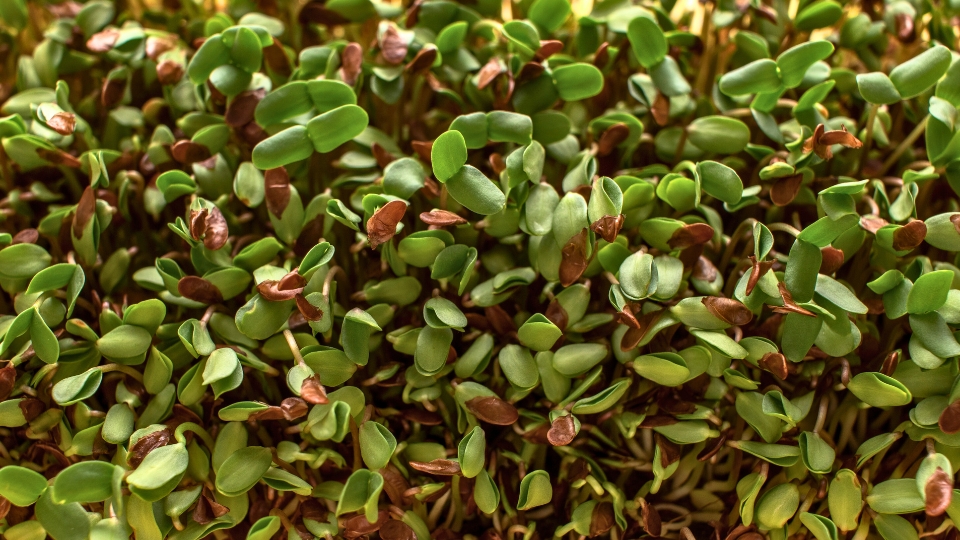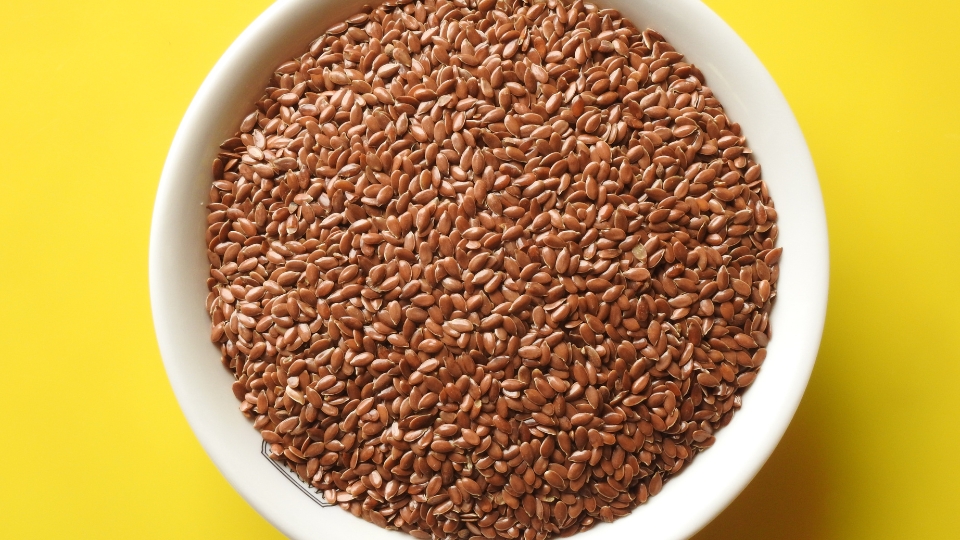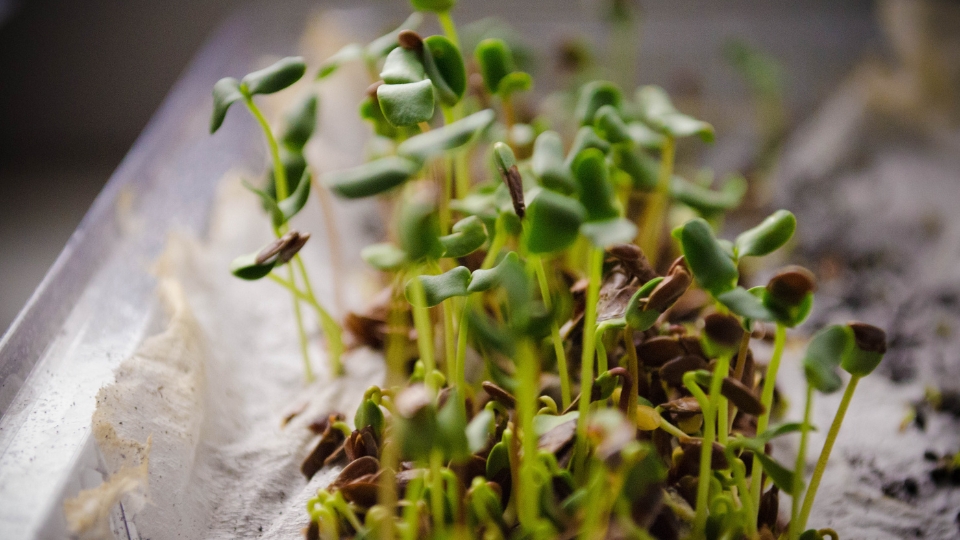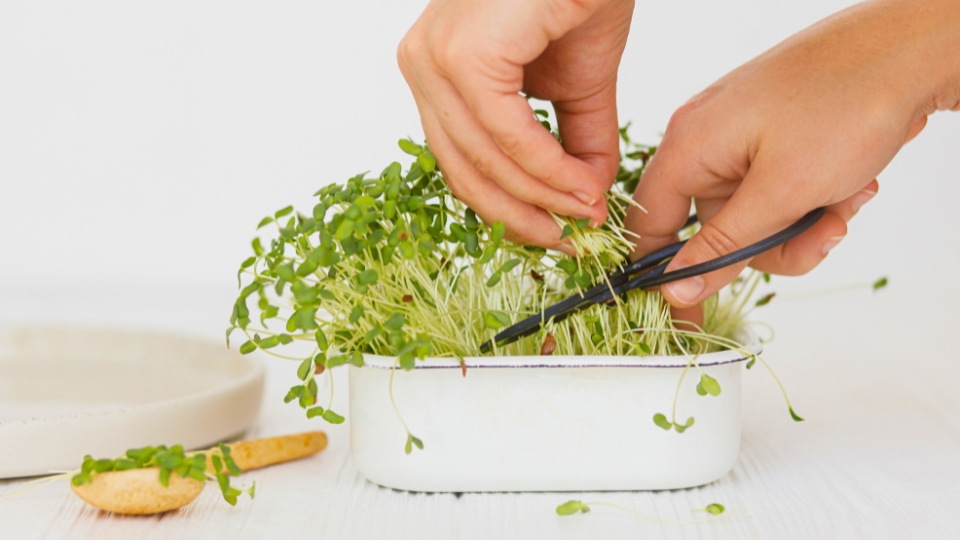To grow flax microgreens, sow the seeds in a tray lined with moist soil, keep them in a warm spot, and mist them daily until they grow to 1-2 inches. Flax microgreens are nutrient-dense plants that can easily be grown indoors with minimal effort.
These tiny seedlings are packed with vitamins, minerals, and fibre, making them a healthy addition to your diet. Growing flax microgreens at home is a simple and rewarding process that requires just a few basic steps. We will guide you through growing flax microgreens from preparation to harvest.
So, let’s get started and learn how to grow these nutritious greens right in your kitchen!
Understanding Flax Microgreens
Flax microgreens are a nutritious and flavorful addition to any meal. Learn how to grow them with ease and enjoy the benefits of these small but powerful greens.
What Are Flax Microgreens?
Flax microgreens are the young and tender shoots of flax seeds harvested when they are just a few inches tall. These miniature plants pack a powerful punch for nutrition and are becoming increasingly popular in the culinary world. Flax microgreens have a vibrant green colour and a delicate, crisp texture, adding fresh and exciting elements to salads, sandwiches, and other dishes.
Nutritional Benefits Of Flax Microgreens
Despite their tiny size, flax microgreens are bursting with nutritional benefits. These baby plants are rich in essential vitamins such as vitamins C, E, and K and essential minerals including potassium, magnesium, and zinc. They are also an excellent source of dietary fibre, which aids digestion and promotes a healthy gut.

One of the standout nutritional properties of flax microgreens is their high concentration of omega-3 fatty acids. Omega-3 fatty acids are known for their cardiovascular benefits and are essential for brain health and cognitive function. Incorporating flax microgreens into your diet is an easy way to boost your intake of these beneficial fats.
Why Grow Flax Microgreens?
Growing your flax microgreens is a rewarding and cost-effective way to enhance your meals with a nutritional powerhouse. Here are a few reasons why you should consider growing flax microgreens:
- Freshness: When you grow flax microgreens at home, you can harvest them at their peak of freshness. This means maximum flavour and nutritional value for your dishes.
- Convenience: Flax microgreens are easy to grow and require minimal space. Whether you have a garden, a balcony, or even a sunny windowsill, you can grow these mini greens successfully.
- Cost savings: Purchasing flax microgreens from the supermarket can be expensive. By growing your own, you can save money while still enjoying the benefits of this nutrient-dense food.
- Health benefits: Regularly consuming flax microgreens can promote a well-balanced and nutritious diet. These microgreens’ abundance of vitamins, minerals, and omega-3 fatty acids can help support overall health and well-being.
Choosing The Right Seeds
Learn how to grow flax microgreens successfully with the right seeds. Follow these simple steps for a bountiful harvest of nutritious and flavorful microgreens at home.
Selecting High-quality Flax Seeds
When growing flax microgreens, choosing the right seeds is crucial for a successful harvest. By selecting high-quality flax seeds, you ensure your microgreens will thrive and yield a nutritious yield.

Here are some key factors to consider when selecting your flax seeds:
- Appearance: Look for seeds that are uniform in size, with a smooth and glossy outer coating. Avoid any seeds that are discoloured or have an irregular shape.
- Fragrance: Good-quality flax seeds will have a mild, nutty aroma. If the seeds have a rancid smell, it’s a sign that they may be old or of poor quality.
- Texture: Gently squeeze a few seeds between your fingers. The seeds should feel firm but not overly hard. Avoid seeds that are too soft or brittle, as these may have low viability.
Organic Vs. non-organic Seeds
When deciding between organic and non-organic flax seeds, it’s important to understand the differences and choose what aligns with your values and preferences.
Organic flax seeds are grown without synthetic fertilizers, pesticides, or GMOs. They are produced using environmentally friendly farming practices, prioritising soil health and biodiversity. Choosing organic seeds can contribute to a healthier ecosystem and minimize exposure to potentially harmful chemicals.
On the other hand, non-organic flax seeds may be more affordable and readily available. While they may still provide a good yield, remember that these seeds may have been treated with chemical-based pesticides and fertilizers. Opting for certified organic flax seeds is best if you prioritise organic and sustainable practices.
Where To Buy Flax Seeds
The popularity of growing microgreens has led to increased availability of flax seeds. There are several options when it comes to purchasing seeds for your flax microgreens:
- Local Nurseries or Stores: Check your local nurseries, garden centres, or health food stores. They often carry a variety of seeds, including flax.
- Online Retailers: Many reputable online retailers specialize in selling seeds for microgreens and sprouts. Ensure that you choose a trusted source with positive reviews to ensure the quality of the seeds.
- Seed Banks or Farmers’ Markets: Seed banks and farmers’ markets can be great places to find unique seed varieties, including flax. These options allow you to support local growers and provide a more direct connection to the source of your seeds.
Remember to read customer reviews, compare prices, and consider shipping options when purchasing flax seeds online. It’s also worth checking if the seller offers additional information or tips on growing microgreens using their seeds.
Preparing The Growing Medium
Preparing the growing medium is a crucial step in growing flax microgreens successfully. The ever-increasing medium refers to the material in which the seeds will be planted and nurtured until they are ready for harvest.
Choosing the right growing medium, preparing the soil or tray, and adding necessary amendments are essential to creating a favourable environment for your flax microgreens to thrive.
Choosing The Right-Growing Medium
You have a few options when choosing the right growing medium for your flax microgreens. You can use soil or soilless alternatives such as coconut coir or peat moss.
Soil provides a natural and nutrient-rich environment for the microgreens to grow, while soilless mediums offer better drainage and can be more hygienic. Choose a growing medium based on your preferences and the specific needs of your flax microgreens.
Preparing The Soil Or Tray
If you choose soil as your growing medium, preparing it properly before planting the flax seeds is crucial. Start by ensuring the soil is free from debris or unwanted materials.
Remove any rocks, weeds, or large clumps of dirt that could hinder the growth of your microgreens. Break up the soil and make it loose, providing a suitable texture for the roots to penetrate and establish themselves.
Adding Necessary Amendments
In addition to preparing the soil or tray, you may need to add necessary amendments to enrich the growing medium with nutrients. The flax microgreens will benefit from a balanced mix of macronutrients and micronutrients.
Consider incorporating organic matter, such as compost or aged manure, to improve the fertility of the soil and enhance its water-holding capacity. This will help provide a favourable environment for the flax microgreens to develop and flourish.
Choosing the right growing medium, preparing the soil or tray effectively, and adding necessary amendments set the foundation for healthy and vibrant flax microgreens. Taking the time to prepare the growing medium adequately will significantly contribute to the success of your microgreens and ensure a bountiful harvest.
Germination And Sowing
Germination and sowing are crucial steps in growing healthy and vibrant flax microgreens. You can ensure a successful harvest by following proper techniques and creating optimal conditions. Here’s a breakdown of the key aspects to consider:
Soaking And Preparing The Seeds
Before you start sowing flax microgreen seeds, it is essential to soak and prep them properly. This will facilitate germination and enhance the growth of the microgreens.
To soak the flax seeds:
- Take the desired amount of flax seeds and place them in a clean bowl.
- Fill the bowl with filtered water until the seeds are completely submerged.
- Allow the seeds to soak for 12 to 24 hours.
After soaking, drain the water and rinse the seeds thoroughly. This helps to remove any residue and prepares the seeds for sowing.
Sowing Techniques For Flax Microgreens
Sowing flax microgreens is a simple process that requires attention to detail. Here are the steps to follow:
- Choose a container with drainage holes, such as a shallow or seedling tray.
- Fill the container with a well-draining and nutrient-rich soil mix, leaving about half an inch of space from the top.
- Evenly spread the prepped flax seeds on top of the soil, ensuring they are not too close together.
- Gently press the seeds into the soil using your fingertips or a small tool, ensuring they have good contact with the soil.
- Cover the seeds with a thin layer of soil approximately 1/8 inch deep.
Once the flax seeds are sown, mist the soil lightly with water. Avoid overwatering, as it can lead to mold or root rot. Place the container in a warm, well-lit area away from direct sunlight.
Optimal Growing Conditions
To ensure successful growth of flax microgreens, it is important to provide optimal growing conditions. Here are some factors to consider:
- Temperature: Maintain a temperature range of 65 to 75°F (18 to 24°C) for ideal germination and growth.
- Light: Flax microgreens require moderate to high light intensity. Place them near a sunny window or use artificial grow lights.
- Air Circulation: Adequate air circulation prevents mold or fungal growth. Use a small fan to ensure proper air movement.
- Watering: Water the microgreens gently, keeping the soil moist but not waterlogged. Use a spray bottle or watering can with a fine nozzle.
- Harvest Time: Flax microgreens are ready to harvest when they reach a height of about 2 inches. This typically takes about 10 to 14 days.
You can grow healthy and flavorful flax microgreens by following these germination and sowing techniques and providing optimal conditions. Enjoy the process and reap the nutritious rewards of your homegrown microgreens!
Caring For Flax Microgreens
When it comes to growing flax microgreens, proper care is essential for their successful development. Caring for flax microgreens involves providing the right watering and humidity conditions, ensuring adequate lighting, and preventing common pests and diseases.

Watering And Humidity Requirements
Watering is an important factor in the growth of flax microgreens. These delicate sprouts require the right amount of moisture to thrive. Keep the growing medium moist to ensure optimal growth, but avoid overwatering. Overwatering can lead to root rot and other issues that hinder the growth of the microgreens.
Also, maintaining proper humidity levels is crucial for developing flax microgreens. A humidity level of 40% to 60% is generally recommended. You can achieve this by placing a tray filled with water near the growing tray or using a humidifier. Regularly monitor the humidity levels to make necessary adjustments.
Providing Adequate Lighting
Light plays a vital role in the growth and development of flax microgreens. These tiny plants require sufficient light to produce healthy and flavorful greens. Place your growing tray in a well-lit area or use artificial grow lights for best results.
Cover the tray with a lid or blackout cloth during germination to encourage the seeds to sprout. Once the sprouts emerge, remove the cover and expose the microgreens to direct light. Aim for 12 to 16 hours of light per day, which helps promote photosynthesis and ensures optimal growth.
Avoiding Common Pests And Diseases
Flax microgreens can be susceptible to pests and diseases, significantly hindering their growth. It is important to take preventive measures to keep your microgreens healthy and pest-free.
Start by ensuring cleanliness in the growing area. Regularly sanitize the tray and your tools, and maintain proper ventilation. This helps reduce the risk of common pests and diseases.
In addition, be mindful of signs of pest infestations, such as yellowing leaves or tiny insects. If you notice any pests, you can try natural pest control methods like neem oil or introduce beneficial insects like ladybugs.
By implementing proper care practices and being vigilant against pests and diseases, you can ensure the successful growth of vibrant and healthy flax microgreens.
Flax Microgreens Harvesting And Storage
To successfully grow flax microgreens, follow these steps for harvesting and storage. After reaching the desired growth, gently cut the microgreens above the soil line. Rinse and dry them thoroughly before storing them in a sealed refrigerator container to maintain freshness.
Determining The Right Harvest Time
Knowing when to harvest your flax microgreens is crucial to ensuring they have reached their peak flavour and nutritional value. Harvesting too early or too late can produce a subpar taste and texture.

The ideal harvest time for flax microgreens is when they have grown to a height of 1 to 1.5 inches and have developed their first set of true leaves, which usually takes 7 to 14 days after germination.
Harvesting Techniques For Flax Microgreens
When harvesting your flax microgreens, you have a few options. The first method is using clean scissors to cut the microgreens just above the soil level carefully. This simple and efficient method allows you to harvest the greens while leaving the roots intact for continuous growth.
Another technique involves gently grasping the microgreens close to their base and pulling them out of the growing medium by hand. This method works best when the microgreens are well-rooted and have strong stems, preventing damage during harvest.
Proper Storage Methods
Once you have harvested your flax microgreens, it is important to store them properly to maintain their freshness and extend their shelf life. Follow these storage methods:
1. Rinse and dry:
Before storing, rinse the harvested microgreens under cold water to remove dirt or debris. Pat them dry gently using a clean kitchen towel or paper towels, ensuring they are completely dry before storage.
2. Use airtight containers:
Transfer the microgreens into airtight containers or resealable plastic bags. Keeping them in a sealed environment prevents moisture loss and preserves their vibrant colour and crunchiness.
3. Refrigerate:
Place the containers or bags in the refrigerator, preferably in the crisper drawer, where the temperature and humidity are more stable. The recommended temperature for storing flax microgreens is around 35 to 40 degrees Fahrenheit (2 to 4 degrees Celsius).
4. Consume within a few days:
Flax microgreens are best consumed within a few days of harvesting to enjoy their optimal taste and texture. While they can still be consumed after a week of storage, their flavour and nutrient content may gradually decline.
By following these harvesting and storage techniques, you can ensure that your flax microgreens stay fresh and delicious, ready to enhance your salads, sandwiches, and other dishes with their nutty flavour and nutritional benefits.
Flavor Pairings And Culinary Uses
Discover the perfect flavour pairings and culinary uses for flax microgreens, a nutritious and versatile ingredient you can easily grow at home. Explore different ways to incorporate these vibrant greens into your dishes for freshness and taste.
Enhancing Dishes With Flax Microgreens
Flax microgreens are visually appealing and possess a unique flavour that adds depth and complexity to various dishes. Incorporating these nutritious greens into your culinary creations can elevate the overall taste profile and provide an exciting twist. Here are some creative ideas to enhance your dishes with flax microgreens:
Creative Flavor Combinations
Pairing flax microgreens with complementary flavours can result in exquisite and memorable dishes. Here are some creative flavour combinations to consider when using flax microgreens in your recipes:
- 1. Citrus and Flax: The tangy citrus flavours pair exceptionally well with flax microgreens’ earthy and nutty taste. Squeeze lemon or lime juice over your flax microgreens to enhance their natural flavours.
- 2. Roasted Vegetables and Flax: Roasting vegetables brings out their natural sweetness, contrasting with the mild bitterness of flax microgreens. Top your roasted veggies with a handful of flax microgreens for added texture and flavour.
- 3. Creamy Dishes and Flax: Creamy sauces like hollandaise or béchamel provide a smooth and velvety base for flax microgreens to shine. The creaminess of the sauce complements the delicate crunch of the microgreens, creating a harmonious balance of flavours and textures.
- 4. Spicy and Flax: Transform your spicy dishes into a taste sensation by garnishing them with flax microgreens. The peppery kick of the microgreens adds a refreshing and cooling element to balance the heat.
Incorporating Flax Microgreens In Different Cuisines
Flax microgreens can be incorporated into various cuisines, allowing you to explore a world of flavours while reaping their nutritional benefits. Here are some examples of how you can infuse flax microgreens into different culinary traditions:
| Cuisine | Ideas for Incorporating Flax Microgreens |
|---|---|
| Italian | Add flax microgreens to a classic Caprese salad, or sprinkle them on a freshly baked pizza for a delightful twist. |
| Asian | Enhance the flavour and presentation of your sushi rolls by using flax microgreens as a vibrant and nutritious garnish. |
| Middle Eastern |
Include flax microgreens in your falafel wraps or atop hummus for an added crunch and nutritional boost. |
| Mexican | Spice up your tacos or enchiladas by sprinkling a handful of flax microgreens over the fillings to introduce a new layer of texture and flavour. |
Remember that flax microgreens are versatile and can be used where you typically use herbs or leafy greens. Don’t be afraid to experiment and explore different culinary possibilities with these tiny flavour powerhouses. Enjoy the delightful combination of taste and nutrition that flax microgreens bring to your dishes!
Common Mistakes To Avoid
Many beginners make a few common mistakes when growing flax microgreens. These mistakes can hinder the growth and development of your flax microgreens, resulting in a less-than-ideal harvest. By being aware of these mistakes and taking the necessary precautions, you can ensure a thriving crop of flax microgreens.
Overwatering And Under-watering
Overwatering or under-watering your flax microgreens can have detrimental effects on their growth. It’s essential to find the right balance when it comes to watering. Flax microgreens prefer moist conditions but not soaking wet. They should be watered regularly, but not excessively.
Overwatering can lead to root rot and mould growth, while underwatering can cause the microgreens to become stunted and wilted. Regularly checking the growing medium’s moisture level is essential to avoid these issues. Stick your finger into the soil up to your first knuckle, and if it feels dry, it’s time to water.
Insufficient Light Or Improper Positioning
Insufficient light or improper positioning can greatly impact the growth of your flax microgreens. These plants require adequate light to carry out photosynthesis and promote healthy growth. Without enough light, your flax microgreens may become leggy and weak.
When positioning your microgreens, ensure they are placed in a location that receives direct sunlight for at least four to six hours a day. If natural light is not available or consistent, you can use artificial grow lights placed one to two inches above the trays to provide the necessary light.
Skipping Proper Sanitation
Skipping proper sanitation can lead to the growth of harmful bacteria and fungi, compromising the health of your flax microgreens. Before sowing the flax seeds, it’s crucial to thoroughly clean and sanitize the growing trays, containers, and any other equipment you will be using.
To ensure proper sanitation, clean the trays and containers with 1 part bleach to 9 parts water. Rinse them thoroughly and allow them to dry before proceeding with the growing process. This will help eliminate any potential pathogens that could harm your microgreens.
Frequently Asked Questions For How To Grow Flax Microgreens
Can I Grow Flaxseed Microgreens?
You may grow flaxseed microgreens. Follow these 5 success tips: 1. Use organic flax. 2. Let seeds soak for 6-12 hours. 3. Spread in a tray of well-draining soil. 4. Moisten soil and provide indirect sunlight. 5. Harvest greens at 1-2 inches.
How do you grow flax sprouts?
To grow flax sprouts, start by soaking flax seeds overnight in water. Drain and rinse the seeds, then spread them in a single layer on a tray or dish. Keep the seeds moist by spraying them with water daily.
In about 5-7 days, your flax sprouts will be ready to harvest and enjoy!
How Difficult Is It to Grow Flax?
Growing flax can be moderately challenging but not overly difficult. Adequate soil preparation, regular watering, and proper weed control are important. Flax requires full sun and well-drained soil. Harvesting involves pulling the plants or using machinery. With proper planning and care, growing flax can be a rewarding experience.
Decision
Growing flax microgreens can be a rewarding and beneficial addition to your home garden or culinary pursuits. You can enjoy these tiny greens’ nutritious and delicious benefits with simple steps. Ensure adequate light, moisture, and care to ensure successful growth.
Whether you’re a seasoned gardener or just starting, flax microgreens are a versatile and easy-to-grow option that can enhance your meals and provide a fresh flavour. So why not experience the joy of growing your flax microgreens today?
This Video Source: https://www.youtube.com/watch?v=z7tfvp6d_hQ



